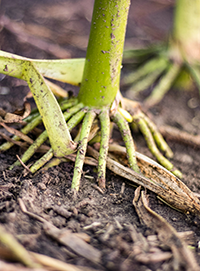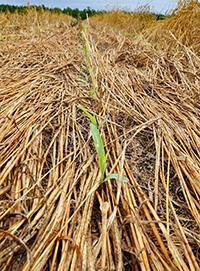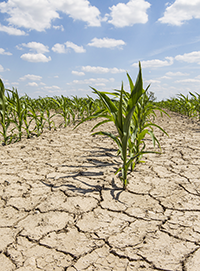For farmers seeking to grow their businesses and invest in long-term success, there’s an opportunity to embrace sustainable agriculture in a way that both drives farm profits and improves environmental impact. Sustainable farming has the potential to increase yield, decrease costs, and improve the long-term productive potential of a farm.
Sustainability is a term that is often tossed around without a clear definition or is sometimes confused with organic farming. Let’s take a closer look at what sustainable farming looks like and how more growers are successfully introducing it to their farms.
Taking Small, Achievable Steps Toward Sustainable Agriculture
Sustainability comes from the philosophy of how you steward your land and design your operations. By focusing on areas such as soil health, nutrient management and water stewardship, you can not only improve the sustainability of your operation and preserve your resources for decades of future farming, but also potentially benefit your bottom line.
Becoming more sustainable doesn’t always require major capital investments or a sea change in how farms operate. In just a few small steps, you can start to embrace more sustainable growing practices and roll them out over time.
What Is Sustainable Agriculture?
Sustainable agriculture is the act of fulfilling current food and textile needs while enabling future generations to provide for themselves in the same way. As the University of California Agriculture and Natural Resources department notes, “Every person involved in the food system—growers, food processors, distributors, retailers, consumers, and waste managers—can play a role in ensuring a sustainable agricultural system.”
Growers play just one role in these systems, but there are plenty of benefits they can enjoy as they implement sustainable practices:
- Sustainable agriculture may reduce costs. In a recent study, researchers found that regenerative agriculture practices in corn fields offered 78% higher profits over traditional corn production systems.
- Sustainable agriculture improves soil health. As the Environmental and Energy Study Institute notes, sustainable farming practices improve various aspects of soil health and leave land healthier long-term.
- Sustainable agriculture reduces environmental impact. By reducing greenhouse emissions, water pollution, and other contributors to climate change, you can lend a helping hand to the long-term health of the planet.
How to Get Started with Sustainable Agriculture
Getting started with sustainable agriculture can be easy. Begin by embracing these simple strategies in your growing operation:
1. Focus on nutrient management
 Healthy land is an essential natural resource that impacts both your livelihood and ability to feed a growing global population. As you work your fields, it’s important to think about preventing nutrient loss and even adding nutrients needed to help improve the soil’s productivity—and overall health for Mother Nature.
Healthy land is an essential natural resource that impacts both your livelihood and ability to feed a growing global population. As you work your fields, it’s important to think about preventing nutrient loss and even adding nutrients needed to help improve the soil’s productivity—and overall health for Mother Nature.
Nutrient management is an essential part of your ongoing farm design and planning. University of Georgia’s Sustainable Agriculture notes that there are four key steps to nutrient management in sustainable agriculture, including:
- Testing your soil to understand current nutrient profiles and any deficiencies
- Selecting fertilizers and developing an application strategy, ideally one that aligns with 4R Nutrient Stewardship principles
- Accounting for nutrient inputs from organic sources like manure or compost
- Ongoing management, which may include supplementing the soil with one of the 20 nutrients that plants need to grow
Adding nitrogen is a key element of farming for certain crops, such as corn. When used in connection with solutions such as nitrogen stabilizers, it can help establish a more stable baseline nutrient profile for soil. Ultimately, nitrogen stabilizers help prevent nitrogen loss through leaching into groundwater and reduce denitrification that releases greenhouse gasses.
Innovative strategies often bring together a variety of solutions for nutrient management. Fifth-generation Iowa farmer Zack Smith has been implementing sustainable practices for years—including tillage and planting cover crops. Recently, he took his efforts to the next level and built an autonomous mobile barn that supports a strategy he calls “stock cropping.”
In his model, livestock and crops work together symbiotically while creating a virtuous cycle that improves soil health by naturally replenishing nutrients and ultimately achieving higher yields. The barn is designed to move approximately 10 feet each day along a crop line and contains space for livestock and catching rainwater.
As you make more conscious choices over time, your farm’s nutrient health will improve. Ultimately, that can increase yields today and preserve the soil integrity for the future.
2. Invest in soil health
 Nutrient management is just one component of a healthy farm that’s part of a broader conversation around soil health. Healthy soil, after all, is the foundation of productive, sustainable agriculture. As the U.S. Department of Agriculture notes, “Managing for soil health allows producers to work with the land—not against—to reduce erosion, maximize water infiltration, improve nutrient cycling, save money on inputs, and ultimately improve the resiliency of their working land.”
Nutrient management is just one component of a healthy farm that’s part of a broader conversation around soil health. Healthy soil, after all, is the foundation of productive, sustainable agriculture. As the U.S. Department of Agriculture notes, “Managing for soil health allows producers to work with the land—not against—to reduce erosion, maximize water infiltration, improve nutrient cycling, save money on inputs, and ultimately improve the resiliency of their working land.”
While nutrient management and soil health are inextricably linked, growers can also use other strategies and practices to support long-term soil health:
- Rethink soil tillage. Minimizing disturbance is a cornerstone of healthy soil. The rise of no-tillage or low-tillage farming methods helps keep disturbance to a minimum so land can retain nutrients. As Iowa State University Extension notes, there are a variety of benefits for growers to consider a no-till or low-till approach: It may minimize soil moisture loss from the soil’s surface and maximize soil moisture storage while enhancing the physical properties of soil that can increase its moisture storage.
- Plant cover crops. Growers are also finding success by diversifying the way they provide soil cover. Cover crops can help address a variety of challenges around soil health and also have a positive bottom-line impact. In fact, studies have found that corn farmers can expect a 3% increased yield and soybean farmers a 4.9% increased yield after 5 years of continuous cover crop use. When the 9,500-acre Cronin Farms operation in South Dakota began a process to rotate in nine cover crops that also serve as feed for their livestock, they saw dramatic improvements. Today, their yield exceeds the state average, and they spend $6 in inputs versus the industry average of $10 as a result of their sustainable farming approach.
- Expand biodiversity. Research from Colorado State University highlights that soil is home to nearly 25% of the world’s biodiversity. Adding organic material to the soil, rotating crops, and bringing livestock into an area all help increase biodiversity—and provide better nutrients for growth.
3. Practice water stewardship
 Water stewardship is also a critical element of successful sustainable farming. The World Bank notes that irrigated agriculture represents 20% of the total cultivated land and contributes 40% of the total food produced worldwide.
Water stewardship is also a critical element of successful sustainable farming. The World Bank notes that irrigated agriculture represents 20% of the total cultivated land and contributes 40% of the total food produced worldwide.
Stewarding water has two goals. The first is ensuring that you have the water needed to grow your crops. The second is protecting the broader water ecosystem your farm intersects with.
There are many ways to steward water, including:
- Enhancing management practices. Both the inputs and outputs of farming must be managed. The pest management products, nutrient support, and other inputs that go into fields can leach into nearby water sources. With careful management, it’s possible to keep these important resources working for your farm while also ensuring they don’t contaminate nearby water supply.
- Introducing filtration strategies. It’s not always feasible to completely eliminate runoff. However, by focusing on filtration, growers can minimize the impact that runoff has on the local water supply. The right plans can help keep chemicals, sediment, and waste out of the downstream water supply. Consider filtration strategies such as filter strips, bioreactors, or Riparian forest buffers, depending on your farm’s layout.
- Fighting erosion. Cultural practices that fight erosion serve a dual purpose: improving soil health while decreasing the negative impact on the water system. There are a number of practices that minimize soil disturbance, which in turn reduces erosion. Some solutions to consider include no-till or low-till planting, crop rotation, and planting cover crops.
- Planting products that perform in water-limited environments. If you farm in an area where water supply is limited or drought frequently occurs, consider selecting seed that is bred and tested to be highly resilient in dry conditions. Corn hybrids designed for water-limited environments can protect your valuable yield in dry years, without requiring intensive water use.
Planting the Seeds of Sustainable Farming
Embracing sustainable farming can have a significant impact on your growing operation, from preserving soil for future crops to improving the bottom line. As you plan for next season, consider exploring whether small changes in your nutrient management strategies or soil tillage practices, investing in soil health, or focusing on water stewardship could be your next step toward a more sustainable farm.
Not only will you see rewards to your yield and profits, but you’ll be laying the foundation for long-term growth and land that’s ready to continue producing for generations to come.
The More You Grow
Find expert insights on agronomics, crop protection, farm operations and more.
Maximize Your Farm's Sustainability

We're in It for Good
Sustainability matters more than ever for farmers, for the land, in our communities, and in our operations. Corteva Agriscience is committed to advancing sustainable agriculture to enrich lives and our planet for generations to come.
See our commitment